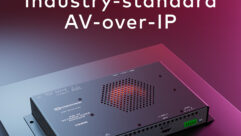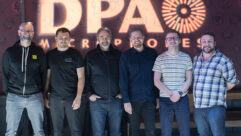Looking ahead
Mar 1, 2000 12:00 PM,
Kim Doyle
The NSCA University, originally featured at last year’s Expo, continues topresent high-tech solutions for a technologically progressive industry.
It may be obvious that the goal of any business out there is to besuccessful, but how you measure success varies from industry to industryand company to company. In the systems integration industry, companiesoften consider themselves successful if they have enough technicians tocomplete the big new job they just landed, or if they squashed all thefires they needed to today. Indeed, these are real issues with seriousimplications if not met, but what about the big-picture challenges that, ifmastered, go a long way toward securing professional success in the future- such issues as offering your customer the latest in systems integrationexpertise and single-source accountability? As our industry continues tomove away from bid work, can you offer the total low-voltage package in anegotiated contract?
It is for these reasons that the NSCA created the NSCA University: ATechnology Pavilion. Now a major attraction at the NSCA Expo, theUniversity is an interactive network simulation demonstratingcomputer-controlled integration. Modeling a high-tech college campus, theUniversity is sponsored by numerous manufacturers and is set to take thestage again at Expo 2000 from April 29 to May 1, 2000 in Las Vegas.
The first goal
The first of the University’s two goals is to update low-voltagecontractors and consultants on the latest ways to expand the technologicalcapabilities of their businesses.
“In creating the University, the NSCA hopes to simulate theinteroperability of products and technologies in a way previously notconsidered,” said Chuck Wilson, NSCA executive director.
During its debut at NSCA Expo ’99 in Nashville, the University wasoverwhelmingly successful. Hundreds of attendees gathered at the campus fora look at the high-tech simulation, including Ted Barker, general managerof Communication Systems, Casper, WY.
“The technology shown in the University was where the market is going andfor those who didn’t know, it showed where the growth potential is in theindustry,” Barker said. “The University took a lot of mystery out ofintegration.”
For the Expo 2000, attendees interested in learning more than the 15 minuteeducational explanations can offer in a scheduled tour, the NSCA hascreated a direct link with the University and many of the NSCA Expoeducation seminars. Several technical classes will be conducted in thecampus this year to give students a hands-on learning component to theirclass. “Principles of Systems Integration,” “Connecting to the Network,””Contemporary Technologies of the Classroom” and “Voice/Data Convergence onLANs and WANs” will each be conducted in part in the campus. Also, perhapsmore importantly, how to integrate converged technology principles into thecorporate business plan successfully is a topic addressed by numerous Expobusiness seminars, including “Making the A/E Connection,” “SuccessfulDesign-Build Strategies” and “Constructing a Business Plan.”
Building the University
Built by General Communications, Salt Lake City, the University will be setup in the center of the Expo 2000 exhibit floor. Eight separate areas (orrooms) will be featured on the campus to demonstrate a combination ofmultiple technologies controlled on a single network. To demonstrate newideas or offer contractors confirmation of their existing technical skills,the University will show Expo attendees systems designed and integrated ina manner that uses interoperability and functionality rather than aproduct’s specific applicability. Technologies will be frankly explainedand demonstrated in the media center, local classroom, remote classroom, adean’s office, conference room, campus security office, auditorium and acomputer lab.
Before building the campus, several criteria were of major considerationfor the conceptualization and design. First, all individual systems must beintegrated into one master system transparent to the University visitor.Black boxes are not an option; the visitor must be able to see and interactwith actual technology. Secondly, a single-user interface for the operationof all systems throughout the campus is necessary, and allowances foroperation from several locations on the campus and from a remote locationmust be in place. Finally, all protocols used within the campus must becontrolled on a single network.
Steps were taken to ensure that NSCA University technologies represent someof the newest products manufacturers are producing today. The system iscontrolled by Mircosoft Visual Basic software, and its devices arecontrolled via several protocols, including RB232, Internet and IR.Although the system can be controlled from any location on the network, thedesign also allows control via the Internet. Demonstrations of thesetechnologies and others may be seen at the entrance to the University wherea stage and seating space will be available for Expo attendees to listen toeducational sessions being presented by the NSCA and certain manufacturersponsors. This area will be equipped with assistive listening devices notonly for anyone in the audience requiring it, but also to demonstrate thetechnology.
New features
Demonstrating the changing nature of real life projects, new technologieswill be added to the University each year. According to Dan Erickson, vicepresident of General Communications, new video technologies will beshowcased in 2000, including videoconferencing over the LAN using a widearray of video networking equipment developed to ensure cost-effective andreliable use. In one instance, video phones will be demonstrated where theWAN access switch creates an infrastructure for ISDN and T1 lines.
“The benefit of this approach is that it affords the full advantage ofvideoconferencing over a single connection, and by using only oneconnection, you are helping your customer curb the largest cost related tovideoconferencing, which is not the equipment, but the phone charges,” saidErickson.
Another new addition to the University in 2000 is plasma displaytechnology. Plasma display panels (PDPs) will be clipped over plasmascreens, essentially creating a smart board. Features of this particularproduct include touch control, handwriting capabilities and asave-your-work option making it an effective tool for conference rooms,classrooms and others. Video servers are also new to the University’s mediacenter. This video storage device demonstrates the capabilities of studentsviewing DVD or VCR movies or other teaching clips stored on the server andretrievable through the 14 inch (357 mm) touch screens.
Last year’s popular solutions
Carried over from last year but still a major component of the Universityis the use of Internet Protocol (IP) over packet data networks for thetransmission of voice traffic. The University places emphasis on voice overIP because many consider it the future of telephony integration. Althoughthere may be several reasons for this, the most frequently referenced iscost. Especially in the school setting, long-distance telephone chargesquickly become unwieldy. Packet voice uses less transmission bandwidth thanconventional voice; therefore, more may be carried on a given connection.As telephony requires as much as 64,000 bits per second, packet voice, forreasons to be discussed in the campus, often requires less than 10,000. Formany facilities, schools included, there is enough reserve capacity on datanetworks to transport considerable voice traffic, drastically reducing thecost. Demonstration of voice over IP may be found in several campus rooms.
Other technologies demonstrated throughout the campus include additionaladvanced display technologies, such as HDTV, DLV and plasma screens.Challenges typical to conference room environments, including marginallighting and the need for quality audio reproduction were heavily weighedduring conceptualization as they would be on any well-designed andwell-implemented project. To address the issue of lighting,computer-controlled dimmable fluorescent light fixtures have been added fordemonstration.
University visitors can also explore actual networking technologies,including fiber optics, fast Ethernet and gigabit Ethernet. Also featuredwill be the interoperability of media retrieval systems with other varioussource technologies hooked to televisions, including DVD and VCR. Alllocated within an equipment cabinet, each of the sources is IR-controlled.
The second goal
In addition to updating low-voltage contractors on new interoperabilityapproaches and how to integrate those skills into their business plans, theNSCA University was also created to bring a heightened level of awarenessof the electronic systems industry to other construction teamprofessionals. New in 2000, the University will tour other events todemonstrate how our industry can assist architects, engineers and end-usersin creating the intelligent workplaces they need.
“By bringing the University on the road, the NSCA is hopeful that it willbring an increased credibility to our industry, more awareness of ourskills and therefore, more profitability to our bottom lines,” said Wilson.
To meet this goal, an abbreviated version of the University will hit theroad in 2000, appearing at Presentations 2000, a show for high-end trainersand trainer executives/managers (Atlanta, February 21 to 23); CSI 2000, theConstruction Specification Institute’s non-residential construction show(Atlanta, June 22 to 25), and APPA 2000, the Association for HigherEducation Facilities Officers show for educational facility managers (Ft.Worth, TX, July 16 to 18).
There can be little argument anymore that the electronic systems industryis changing. Case in point, the words just used to describe our industry,”electronic systems.” Many professionals out there are already wellequipped to offer integrated solutions and single-source accountability. Increating the University, the NSCA strives to offer a true demonstration ofthe latest and greatest not only for the designers and installers, but alsofor your customers. In the end, everyone will benefit.










